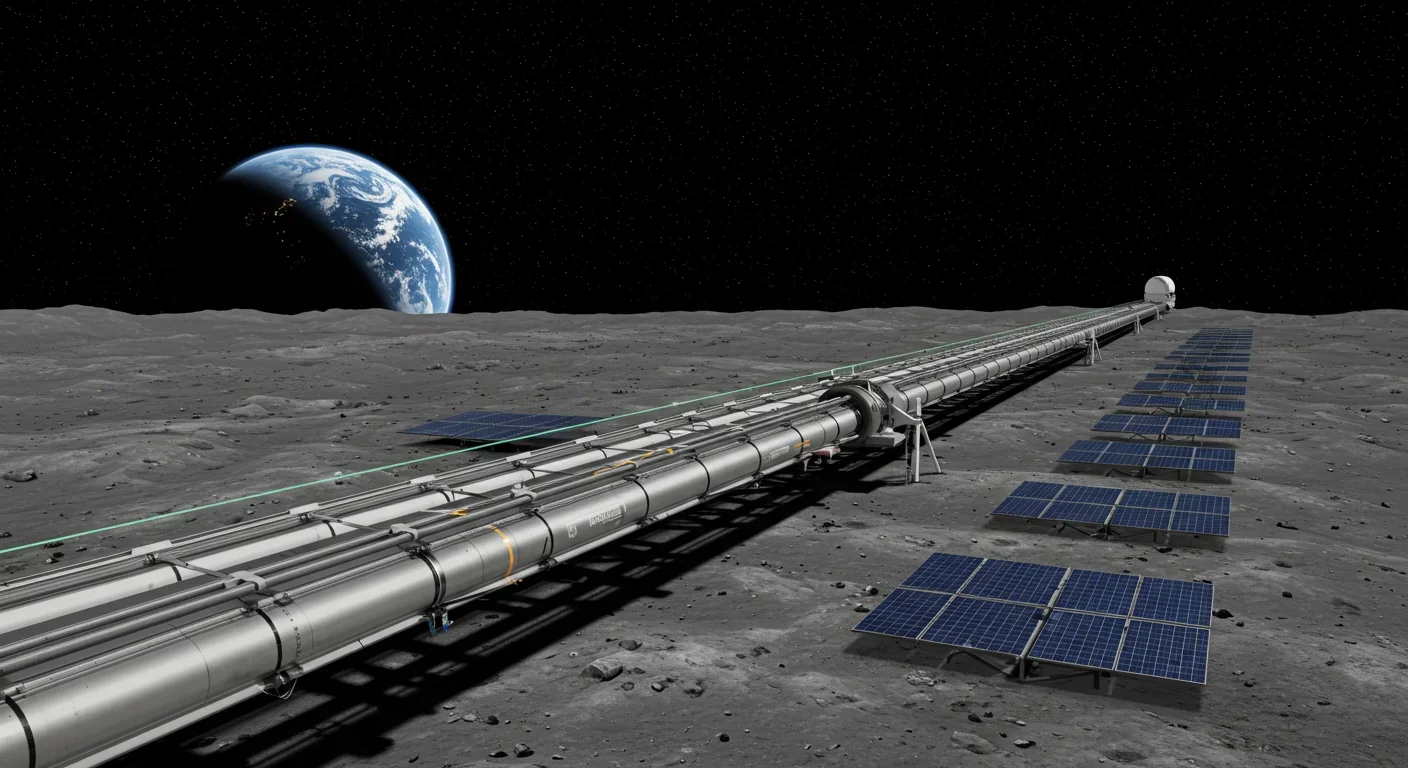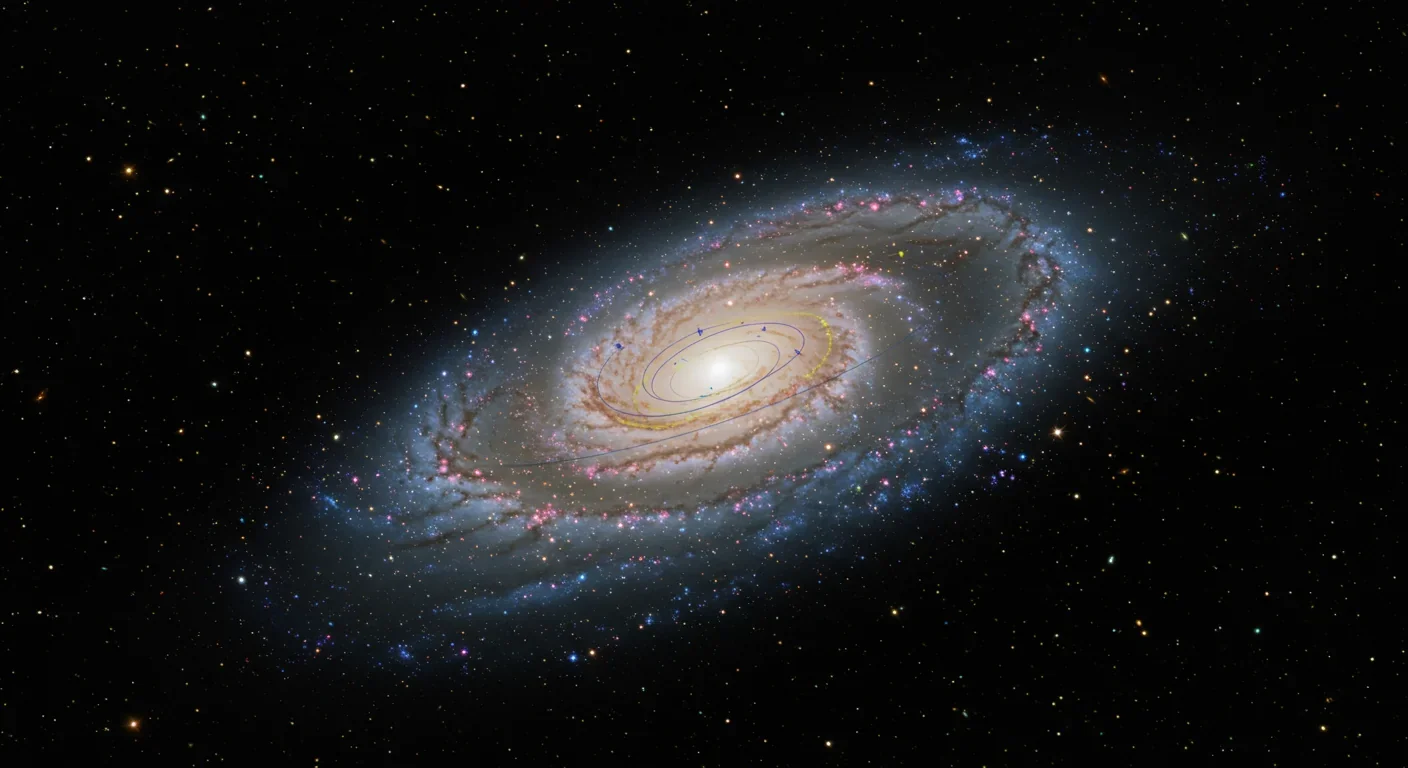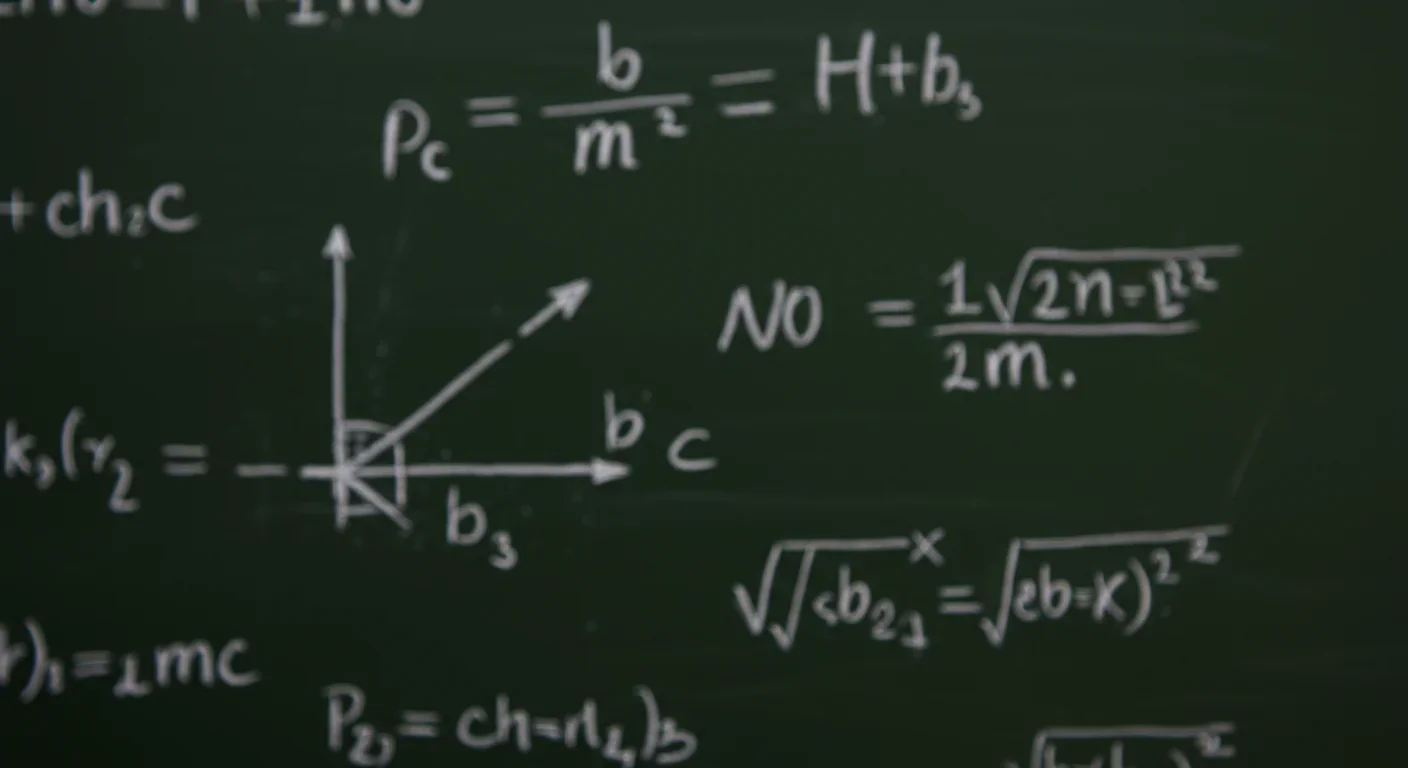Lunar Mass Drivers: Moon Catapults for the Space Economy

TL;DR: MOND proposes gravity changes at low accelerations, explaining galaxy rotation without dark matter. While it predicts thousands of galaxies correctly, it struggles with clusters and cosmology, keeping the dark matter debate alive.

Imagine discovering that one of physics' most fundamental laws—Newton's gravity—simply stops working when things get far apart and slow down. That's exactly what Israeli physicist Mordehai Milgrom proposed in 1983, and it's been driving physicists crazy ever since.
Modified Newtonian Dynamics, or MOND, claims that at extremely weak accelerations—about one ten-billionth of what we feel on Earth—gravity behaves differently than Newton predicted. No invisible dark matter needed. Just a tweak to the rules.
The idea sounds absurd. Newton's laws have worked perfectly for over 300 years. We used them to send spacecraft to Pluto and predict planetary motions with breathtaking precision. Why would they suddenly fail in the outer regions of galaxies?
Because that's where things get weird. When astronomers measured how fast stars orbit in spiral galaxies, they found something impossible. Stars at the edge should be moving slowly, gradually losing speed as you go farther from the galactic center, like planets in our solar system. Instead, they're whipping around at constant high speeds—so fast they should fly apart.
Stars at galaxy edges move so fast they should fly apart, yet they don't. Either invisible matter holds them together, or gravity itself works differently than we think.
The mainstream solution? Galaxies must be embedded in massive halos of invisible "dark matter" that holds everything together through extra gravity. This mysterious substance supposedly makes up 85% of all matter in the universe, yet after four decades of increasingly sensitive experiments, we haven't detected a single dark matter particle.
Milgrom looked at the same data and thought: what if gravity itself changes instead?
MOND's core claim is elegantly simple. When the gravitational acceleration drops below a critical threshold—called a₀, roughly 1.2 × 10⁻¹⁰ m/s²—Newton's inverse-square law transitions to an inverse-linear law. Gravity weakens more slowly than expected.
This threshold isn't arbitrary. It shows up naturally when you compare a galaxy's total mass to the centripetal acceleration needed to hold its outer stars in orbit. Below a₀, MOND gravity gets stronger than Newtonian predictions, providing the extra pull needed to keep stars from flying away.
The beautiful thing? This single parameter, a₀, explains the rotation curves of literally thousands of galaxies. You don't need to guess how much dark matter each galaxy contains or where it's distributed. MOND makes precise, parameter-free predictions based solely on the visible matter.
Stacy McGaugh, an astronomer at Case Western Reserve University who has studied hundreds of galaxy rotation curves, calls MOND's predictive power "spooky." In a 2020 study published in the Astrophysical Journal, McGaugh and colleagues found that the external gravitational field from nearby galaxies affects rotation curves exactly as MOND predicts—a phenomenon called the external field effect. Dark matter theories don't predict this.

The study examined 150 galaxies and found that galaxies experiencing strong external gravitational fields from neighbors showed slower or even declining rotation speeds in their outer regions, precisely matching MOND's equations. In the dark matter paradigm, each galaxy's halo should be largely independent of external influences, yet the data showed otherwise.
MOND's most striking success involves an empirical relationship discovered in 1977 by astronomers R. Brent Tully and J. Richard Fisher. They found that a galaxy's luminosity relates to its rotation speed in a tight, predictable way. Brighter galaxies spin faster, following a precise mathematical formula.
In the dark matter framework, this is puzzling. Why would the amount of invisible dark matter correlate so perfectly with the amount of visible stars? The two supposedly formed through completely different processes.
MOND explains the Tully-Fisher relation naturally. Since MOND ties gravitational behavior directly to the distribution of visible matter at low accelerations, the relationship between stellar mass and rotation velocity emerges automatically from the theory. You don't have to fine-tune anything.
"MOND's predictive power is spooky. The external field effect we observed in 150 galaxies matches MOND's predictions exactly, yet dark matter models don't predict this phenomenon at all."
— Stacy McGaugh, Case Western Reserve University
Even more remarkably, astronomer Stacy McGaugh discovered that the Tully-Fisher law holds for galaxies of all types—not just spiral galaxies but also irregular and dwarf galaxies. A study of 47 galaxies across different morphologies confirmed the relationship holds systematically across the entire galaxy population.
For MOND advocates, this universality is smoking-gun evidence. One modified gravity law explains what dark matter requires an elaborate, fine-tuned conspiracy to produce.
If MOND worked everywhere, dark matter would be dead. But it doesn't.
The most famous problem is the Bullet Cluster, a cosmic collision between two galaxy clusters observed 3.8 billion light-years away. When the clusters smashed together, the hot gas in each cluster collided and slowed down, visible through X-ray observations. But gravitational lensing—the bending of light from background galaxies—revealed that the strongest gravitational pull came not from where the gas ended up, but from where the galaxies (and presumably their dark matter halos) passed through relatively unhindered.

Dark matter explains this beautifully: the galaxies and their invisible halos sailed through each other, while the gas clouds crashed. MOND struggles here. A 2007 analysis by Angus and colleagues showed MOND can reproduce some of the gravitational potential offset between gas and galaxies, but still requires additional missing mass to explain the full lensing signal.
Some MOND proponents, including Milgrom himself, suggest the missing mass might be cold, dense hydrogen gas that hasn't been detected yet. But that feels like adding a fudge factor—exactly what MOND was supposed to avoid.
Galaxy clusters present another challenge. In MOND, even with modified gravity, clusters appear to contain only about one-tenth the mass needed to explain their dynamics and gravitational lensing. A recent 2024 analysis published in Physical Review D found that in MOND, galaxy clusters require a "missing-to-hot-gas density ratio" of roughly 10 in their cores, with a consistent exponential cut-off radius around 400 kiloparsecs.
Why would this ratio be so uniform across different clusters? Dark matter provides a straightforward explanation: massive halos dominate cluster mass. MOND requires either undiscovered baryonic matter or an additional gravitational modification we haven't figured out yet.
After 40 years of searching with increasingly sensitive detectors, physicists still haven't found a single dark matter particle. Yet MOND can't explain cosmic structure without its own fudge factors.
Then there's cosmology. The cosmic microwave background—the afterglow of the Big Bang—encodes information about the universe's matter content and structure formation. Dark matter models match these observations remarkably well. MOND's relativistic extensions struggle to reproduce the same patterns without introducing additional fields or particles that start to resemble dark matter by another name.
Newton's gravity is just an approximation of Einstein's general relativity. For MOND to work in the real universe, it needs a relativistic version that explains gravitational lensing, black holes, and cosmic expansion.
Several attempts exist. The most famous is Tensor-Vector-Scalar gravity (TeVeS), developed by physicist Jacob Bekenstein in 2004. TeVeS introduces additional gravitational fields—a vector field and a scalar field—alongside Einstein's metric tensor to reproduce MOND behavior at galactic scales while maintaining general relativity's successes elsewhere.
But TeVeS has problems. It doesn't naturally explain the cosmic microwave background power spectrum without adding components that look suspiciously like dark matter. Some researchers have proposed that massive neutrinos (around 2 electron volts) could fill this gap, but that starts to feel like sneaking dark matter back in through the side door.
Other relativistic MOND formulations exist—AQUAL, QUMOND, and various field-theory approaches—but none has achieved the elegant simplicity of MOND's non-relativistic version. Each introduces complexity and additional parameters that undermine MOND's original appeal.
The past few years have brought fresh data testing both paradigms. In 2020, a team analyzing the SPARC galaxy database reported detecting MOND's external field effect with statistical significance incompatible with standard dark matter predictions. The study, led by Kyu-Hyun Chae and published in the Astrophysical Journal, examined 150 galaxies and found that neighboring gravitational fields affected internal galaxy dynamics precisely as MOND equations predict.

This should have been bigger news. If confirmed and refined, it's direct observational evidence for modified gravity. Yet the result hasn't shifted the mainstream consensus, partly because alternative explanations involving complex dark matter halo interactions can't be definitively ruled out.
Meanwhile, observations of wide binary stars—pairs of stars orbiting each other at large separations—have become a new testing ground. In MOND, these systems should show enhanced gravitational binding compared to Newtonian predictions, since their orbital accelerations fall below a₀. Some studies claim to see exactly this effect; others find no deviation from Newton. The debate remains unresolved, with both sides accusing the other of statistical biases.
The Milky Way itself has become a MOND battleground. High-precision measurements from the Gaia spacecraft revealed that our galaxy's rotation curve begins declining at large distances from the galactic center, rather than staying perfectly flat. A 2024 analysis published on arXiv explored the cosmological implications of this declining rotation curve.
Dark matter advocates say this is easily explained by adjusting halo models. MOND supporters counter that a declining curve is natural in MOND when you properly account for the Milky Way's disk mass distribution and the external gravitational field from nearby galaxies. But fitting the data requires tweaking the value of a₀—MOND's supposedly universal constant. If a₀ varies between galaxies, the theory loses its predictive power.
If you're not a physicist, MOND's situation might seem baffling. Here's a theory that correctly predicts thousands of galaxy rotation curves using a single parameter, while dark matter requires tweaking invisible halo properties for each galaxy. Why isn't MOND taken more seriously?
Several reasons. First, physics has learned painful lessons about abandoning fundamental laws. Every time someone claims Newton or Einstein got it wrong, they're almost always mistaken. Extraordinary claims require extraordinary evidence, and MOND's cluster and cosmology problems remain serious.
Second, dark matter has explanatory power beyond galactic rotation. It explains the universe's large-scale structure, the cosmic microwave background anisotropies, and the distribution of galaxies across cosmic time. MOND handles individual galaxies brilliantly but struggles with the bigger picture.
Third, there's a plausible dark matter candidate: weakly interacting massive particles, or WIMPs. These hypothetical particles arise naturally in several extensions of the Standard Model of particle physics. While direct detection experiments have so far come up empty after decades of searching, that doesn't prove dark matter doesn't exist—just that it's harder to detect than initially hoped. Alternatively, dark matter might be primordial black holes, axions, sterile neutrinos, or something else we haven't thought of yet.
"We have peered into a new world and have seen that it is more mysterious and more complex than we had imagined. Still more mysteries of the universe remain hidden."
— Vera Rubin, astronomer whose observations launched the dark matter debate
MOND, by contrast, doesn't emerge from a deeper theoretical framework. It's a phenomenological model—an equation that fits observations without explaining why gravity would behave this way. Recent attempts to derive MOND from quantum field theory or thermodynamics haven't gained wide acceptance.
Finally, there's institutional momentum. Thousands of physicists have built careers studying dark matter. Telescopes, particle detectors, and supercomputer simulations are designed around the dark matter paradigm. Paradigm shifts in science don't happen easily, especially when the alternative theory has its own serious problems.

MOND isn't the only game in town anymore. Recent years have seen increasingly sophisticated alternatives to both standard dark matter and MOND.
One intriguing approach, published in 2024 in the Journal of Cosmology and Astroparticle Physics, invokes Vainshtein screening—a mechanism that allows modified gravity to hide near massive objects while emerging at galactic scales. Unlike MOND's universal acceleration threshold, Vainshtein screening creates a mass-dependent "bubble" around each object.
Inside the bubble, gravity remains Newtonian. Outside, it strengthens. The bubble radius scales with the object's mass: about 50,000 astronomical units for the Sun (far beyond Pluto), but thousands of light-years for entire galaxies. This elegantly explains why solar system tests confirm Newton's laws while galactic rotation curves deviate.
The Vainshtein approach also handles the Bullet Cluster more naturally than standard MOND. Because compact galaxy clusters generate bubbles while diffuse gas clouds don't, the gravitational lensing signal naturally follows the galaxies rather than the gas—exactly what's observed.
Is this the long-sought alternative to dark matter? It's too soon to say. The model makes testable predictions, including stronger gravitational lensing around compact galaxies than either dark matter or MOND would predict. Upcoming observations from the James Webb Space Telescope and next-generation gravitational wave detectors may provide definitive tests.
There's an uncomfortable truth lurking in this debate: science isn't purely objective. Thomas Kuhn, in his influential book "The Structure of Scientific Revolutions," argued that paradigm shifts in physics happen not just when new evidence arrives, but when old generations retire and new ones grow up with fresh perspectives.
Many MOND researchers feel their work is unfairly marginalized. Papers proposing dark matter alternatives face greater skepticism from journal editors and referees than papers assuming dark matter exists. Conference talks on MOND get relegated to late-afternoon slots when attendance is thin.
Pavel Kroupa, an astronomer at the University of Bonn and outspoken MOND advocate, has accused the astronomical community of "ignoring evidence" that contradicts dark matter models. He points to cases where dark matter simulations failed to predict galactic properties that MOND gets right, yet receive little critical scrutiny.
Paradigm shifts in science don't happen when new evidence arrives. They happen when old generations retire and new ones grow up thinking differently about the same data.
Dark matter defenders counter that MOND advocates cherry-pick successes while downplaying failures. Yes, MOND predicts rotation curves beautifully, but it cannot explain structure formation, the cosmic microwave background, or clusters without ad-hoc additions. Science must be held to rigorous standards, and extraordinary claims require extraordinary proof.
The truth probably lies somewhere in between. Dark matter's observational failures—decades of null results from direct detection experiments, persistent small-scale discrepancies between simulations and observations—deserve more attention than they sometimes get. At the same time, MOND's inability to provide a complete cosmological framework remains a fatal weakness.
What's clear is that scientific progress requires keeping multiple options open. History is littered with "absurd" ideas that turned out to be true: continental drift, quantum mechanics, expanding universe. Dismissing MOND entirely risks prematurely closing off a potentially revolutionary insight.
How will this debate resolve? Several observations in the coming decade could tip the scales.
High-precision measurements of wide binary star orbits will test whether gravity truly deviates from Newton at low accelerations. If clear MOND signatures emerge across hundreds of binaries, the case for modified gravity strengthens considerably.
Galaxy cluster observations with next-generation X-ray telescopes and gravitational lensing surveys will determine whether the "missing mass" in clusters really requires dark matter or can be explained by modified gravity plus undiscovered baryonic matter.
The James Webb Space Telescope is observing some of the universe's earliest galaxies. How these primordial structures formed and evolved will test both dark matter's hierarchical assembly picture and MOND's alternative predictions for structure growth.
Gravitational wave astronomy, still in its infancy, may reveal whether gravity propagates exactly as general relativity predicts or shows subtle modifications at large scales. The collision of neutron stars or black holes in distant galaxies provides a cosmic laboratory unreachable by other means.
Perhaps most importantly, dark matter detection experiments continue to improve. The next generation of detectors will probe WIMPs with ten times greater sensitivity. If they still find nothing, the case for rethinking dark matter strengthens. If they detect even a single unambiguous dark matter particle, MOND becomes untenable.
The stakes extend beyond galaxy rotation curves. How we answer the dark matter question shapes our understanding of cosmic history, the laws of physics, and the ultimate fate of the universe.
If dark matter exists, the cosmos is far stranger than visible light reveals. Our entire periodic table—all the atoms that make planets, stars, and people—represents a tiny fraction of reality. Most of the universe would consist of something fundamentally alien, permeating space but interacting with ordinary matter only through gravity's faint pull.
If MOND is right, visible matter is all there is. But the laws of gravity, which we thought we understood, break down under conditions common throughout the universe. This opens profound questions: why does a₀ have the particular value it does? Why does gravity change behavior at that specific acceleration threshold? Does this hint at deeper principles we haven't grasped?
Some theorists speculate that MOND's acceleration constant relates to the universe's cosmological constant—the mysterious dark energy causing cosmic expansion to accelerate. The numerical values are suspiciously similar, potentially hinting at a connection between cosmic acceleration and gravity's behavior at low accelerations. If true, MOND might be a clue to understanding dark energy, cosmology's other great mystery.
For now, uncertainty reigns. Most physicists bet on dark matter because it solves more problems than MOND, despite detection failures. A vocal minority champions MOND because its galactic successes seem too precise to be coincidental.
The frustrating reality? Both sides might be partly right. Perhaps dark matter exists but behaves differently than current models assume, and gravity also requires modification in extreme regimes. Or perhaps we're missing something entirely—a third option neither camp has imagined.
What's certain is that something profound is missing from our understanding. Either 85% of the universe is invisible, or the most basic force we experience—gravity—works differently than we think. Both possibilities are humbling.
Vera Rubin, the astronomer whose observations of galactic rotation curves launched this entire debate, died in 2016 without seeing it resolved. She once said: "We have peered into a new world and have seen that it is more mysterious and more complex than we had imagined. Still more mysteries of the universe remain hidden. Their discovery awaits the adventurous scientists of the future."
That future is arriving. Over the next decade, observations will constrain both theories more tightly. One path will likely close while another opens wider. The revolution in cosmology that began when Rubin noticed stars moving too fast continues.
We stand at the threshold of discovering either a new form of matter or new laws of gravity. Either way, the universe is about to get weirder.

Lunar mass drivers—electromagnetic catapults that launch cargo from the Moon without fuel—could slash space transportation costs from thousands to under $100 per kilogram. This technology would enable affordable space construction, fuel depots, and deep space missions using lunar materials, potentially operational by the 2040s.

Ancient microorganisms called archaea inhabit your gut and perform unique metabolic functions that bacteria cannot, including methane production that enhances nutrient extraction. These primordial partners may influence longevity and offer new therapeutic targets.

CAES stores excess renewable energy by compressing air in underground caverns, then releases it through turbines during peak demand. New advanced adiabatic systems achieve 70%+ efficiency, making this decades-old technology suddenly competitive for long-duration grid storage.

Human children evolved to be raised by multiple caregivers—grandparents, siblings, and community members—not just two parents. Research shows alloparenting reduces parental burnout, improves child development, and is the biological norm across cultures.

Soft corals have weaponized their symbiotic algae to produce potent chemical defenses, creating compounds with revolutionary pharmaceutical potential while reshaping our understanding of marine ecosystems facing climate change.

Generation Z is the first cohort to come of age amid a polycrisis - interconnected global failures spanning climate, economy, democracy, and health. This cascading reality is fundamentally reshaping how young people think, plan their lives, and organize for change.

Zero-trust security eliminates implicit network trust by requiring continuous verification of every access request. Organizations are rapidly adopting this architecture to address cloud computing, remote work, and sophisticated threats that rendered perimeter defenses obsolete.